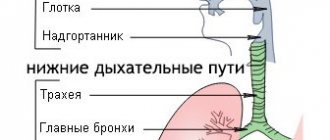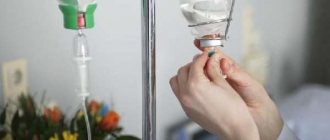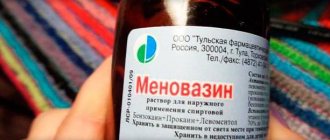Ibuklin Junior is a combination drug based on paracetamol and ibuprofen. Has complex therapeutic activity. Widely used to treat infectious and inflammatory pathologies, and also helps relieve pain and fever. Intended for oral administration to patients of various age categories.
Release form and composition
The dosage form of Ibuclina Junior is dispersible tablets: round, flat, pink with inclusions, have a chamfer and a score on one side and a fruity-mint odor (10 tablets in a blister, 1, 2 or 20 blisters in a cardboard box).
Composition of 1 tablet:
- active ingredients: paracetamol – 125 mg, ibuprofen – 100 mg;
- auxiliary components: corn starch, microcrystalline cellulose, sodium carboxymethyl starch (type A), aspartame, lactose, colloidal silicon dioxide, flavorings, talc, glycerol, magnesium stearate, peppermint leaf oil, coloring.
Ibuklin or Nurofen?
The therapeutic effect of Nurofen is explained by ibuprofen. It is produced in suspension, suppositories, tablets, capsules, gel. In a suitable release form, it is available to patients older than 3 months. Nurofen suppositories are convenient if the child is vomiting.
The medications have similar indications, but the doctor must decide which one is better, since contraindications and tolerability of therapy must be taken into account.
Pharmacological properties
Pharmacodynamics
Ibuklin Junior for children is a combination drug, the effect of which is determined by the properties of its constituent components.
Paracetamol – has antipyretic and analgesic effects, indiscriminately blocks cyclooxygenase (COX).
Ibuprofen is a nonsteroidal anti-inflammatory drug (NSAID) that also has analgesic and antipyretic effects. Its action is due to the inhibition of COX-1 and COX-2 and disruption of the metabolism of arachidonic acid, which reduces the amount of prostaglandins (mediators of pain, inflammation and hyperthermic reaction). It has a suppressive effect on the exudative and proliferative phases of inflammation.
The combination of these substances is more effective in comparison with monotherapy with one of them.
Pharmacokinetics
Paracetamol is highly absorbable. Connection with plasma proteins – ˂ 10%. The maximum concentration is 5–20 mcg/ml and is achieved in 30–120 minutes. Able to cross the blood-brain barrier. Less than 1% of the dose taken is found in breast milk. Metabolism of 90–95% of paracetamol occurs in the liver. The half-life is 2–3 hours. It is excreted mainly by the kidneys.
Ibuprofen, when taken orally, is quickly and almost completely absorbed from the gastrointestinal tract (GIT). The maximum concentration of the substance is reached in 60–120 minutes. The half-life is approximately 2 hours. Communication with plasma proteins – ˃ 90%. Ibuprofen slowly penetrates into the joint cavity and accumulates in the synovial fluid, where its concentration is higher than in plasma. It is excreted mainly by the kidneys and also with bile.
Analogs
Ibuklin Junior
is a powerful non-steroidal drug with anti-inflammatory effects. It can also relieve pain and reduce body temperature. Its effectiveness is explained by the suppression of cyclooxygenase, which leads to a decrease in prostaglandins - mediators of inflammation and pain.
The active ingredients in the drug are ibuprofen and paracetamol. Together they are more effective than individually. The medicine has a number of analogues with the same composition, effect and dosage.
If the drug you need is not available, you can safely replace it.
| Analogue | Active substance | Average price, Russian rubles |
| Brustan | Ibuprofen + paracetamol | 100-130 |
| Next | Ibuprofen + paracetamol | 125-144 |
| Nurofen Long | Ibuprofen + paracetamol | 200-233 |
| Khairumat | Ibuprofen + paracetamol | 190-220 |
| Brufica | Ibuprofen + paracetamol | 110-140 |
| Next Uno Express | Ibuprofen + paracetamol | 240-266 |
| Ibuzam | Ibuprofen + paracetamol | 110-140 |
| Inflagesic Plus | Ibuprofen + paracetamol | 140-170 |
Contraindications
Absolute:
- optic nerve diseases;
- aspirin asthma;
- exacerbation of peptic ulcer of the stomach or duodenum;
- impaired renal or liver function (severe);
- bleeding disorders (hemophilia, hypocoagulation), hemorrhagic diathesis;
- bleeding of any etiology;
- deficiency of glucose-6-phosphate dehydrogenase;
- age up to 3 years;
- increased sensitivity to the components of the drug, other NSAIDs, acetylsalicylic acid.
Relative:
- arterial hypertension;
- chronic heart failure;
- renal or liver failure;
- hyperbilirubinemia;
- nephrotic syndrome;
- history of gastric or duodenal ulcer;
- enteritis;
- gastritis;
- colitis;
- bronchial asthma;
- leukopenia and anemia of unknown etiology.
Nimulid or Ibuklin?
The therapeutic effect of Nimulid is explained by nimesulide. It is available in suspension, gel, tablets. Nimulid in liquid form can be taken by children over 3 years of age.
The medication is recommended not only for lowering temperature and relieving pain, but also for suppressing inflammation in osteoarthritis, bursitis, tendinitis and arthritis of various origins.
The doctor must decide which drug is better, Ibuklin or Nimulid, since they are not interchangeable and it is incorrect to compare them.
Instructions for use of Ibuklin Junior: method and dosage
Ibuklin Junior is taken orally, after dissolving the tablet in 5 ml (teaspoon) of water. The interval between taking tablets should be at least 4 hours, and in case of impaired renal or liver function - at least 8 hours. It is recommended to divide the daily dose into 2-3 doses.
Recommended daily dosage of Ibuklin Junior for children:
- 3–6 years with body weight 13–20 kg: 3 tablets;
- 6–12 years old with a body weight of 20–40 kg: up to 6 tablets.
The duration of use of the drug without medical supervision as an antipyretic should not exceed 3 days, and as an analgesic - 5 days.
Reviews
We studied 100 reviews about the effect of the drug. The analysis showed that 12% of reviews are negative, the rest give a positive description of the medicine.
Here are 4 randomly selected reviews:
- “I give it to my son for the second season of flu, it helps better than paracetamol.”
- “Children’s Ibuklin is planting buds, my baby and I suffered a lot after it - we have been registered for five years.”
- “The drug is great! My daughter is 2.2 years old, the temperature stayed at around 39.5 for a long time, they couldn’t bring it down with anything, Ibuklin worked quickly, the temperature has been at 36.7 for 16 hours.”
- “The medicine is good, it works quickly, the effect lasts a long time.”
We provided information regarding the children's drug Ibuklin, and then, as in the song: “Think for yourself, decide for yourself” - whether to give it to the baby or not...
Overdose
Symptoms of an overdose of Ibuklin Junior: abdominal pain, nausea, vomiting, diarrhea, anorexia, pain in the epigastric region, lethargy, drowsiness, depression, headache, tinnitus, metabolic acidosis, acute renal failure, coma, decreased blood pressure (BP), bradycardia, tachycardia, atrial fibrillation, respiratory arrest.
Recommended treatment: gastric lavage (within the first hour after administration), taking activated charcoal, forced diuresis, alkaline drinking, symptomatic therapy aimed at correcting blood pressure and the general condition of the patient. Other treatment methods are determined individually by the attending physician and depend on the concentration of ibuprofen and paracetamol in the body.
Side effects
The medicine is considered quite toxic and can cause a wide range of side effects. The most common of them are:
- Dyspeptic disorders - vomiting, nausea, abdominal pain, bowel dysfunction, flatulence.
- Development of symptoms of hepatitis and pancreatitis.
- Dry mouth.
- Dizziness and headache.
- Insomnia and drowsiness.
- Anxiety, irritability, excitement, depression.
- Tachycardia, increased blood pressure.
- Shortness of breath, even at rest, bronchospasm.
- Allergic manifestations - rash and dry skin, itching, hyperemia, swelling. Possible urticaria, Quincke's edema.
Less commonly, hyperhidrosis, hallucinations, meningitis, and changes in laboratory blood parameters may occur after taking the drug.
special instructions
The decision to take Ibuklin Junior as an antipyretic drug should be made individually, depending on the severity and tolerability of the febrile syndrome.
Caution should be exercised when using the drug in patients with infectious diseases due to the fact that this may lead to masking of symptoms and complicate the diagnosis.
In order to reduce the risk of developing undesirable effects from the gastrointestinal tract, it is recommended to use the drug in the minimum effective dose, as well as in the minimum course.
When using Ibuklin Junior for more than 5 days in a row, monitoring of peripheral blood and the functional state of the liver is necessary.
To avoid distortion of the results of laboratory tests (quantitative determination of glucose, uric acid in blood serum, 17-ketosteroids), it is recommended to discontinue the drug 48 hours before the start of testing.
Impact on the ability to drive vehicles and complex mechanisms
While taking the drug, it is recommended to refrain from driving vehicles and other complex mechanisms that require rapid psychomotor reactions.
Indications for use for children
The medicine has analgesic, anti-inflammatory and antipyretic properties.
This feature allows mothers to make their babies feel better when :
- colds, ear, nose and throat diseases;
- bruises, dislocations, cuts and other fidget troubles accompanied by pain.
Ibuklin can be given to children when teething, if it is very painful and painful (with high fever).
However, we must not forget that it is not recommended until 2 years of age, so it will be better if the procedure is one-time.
If you want to know how to cure oral thrush in a baby, read our article.
What ointment can be used for stye on the eye in children? We will tell you the answer to the question!
Our other article will tell you about the symptoms of purulent tonsillitis in children.
Drug interactions
Concomitant use of Ibuklin Junior with other NSAIDs is contraindicated.
- paracetamol: the risk of nephrotoxic effects increases;
- glucocorticosteroids, ethanol, corticotropin: the risk of erosive and ulcerative lesions of the gastrointestinal tract increases;
- anticoagulants (direct, coumarin and indandione derivatives), thrombolytic agents (alteplase, anistreplase, streptokinase, urokinase), antiplatelet agents, colchicine: the risk of hemorrhagic complications increases;
- indirect anticoagulants: blood clotting should be monitored;
- insulin, oral hypoglycemic drugs: their hypoglycemic effect increases;
- diuretics, antihypertensive drugs: their effect decreases;
- methotrexate, digoxin, lithium preparations: their concentration in the blood increases;
- caffeine: the analgesic effect of Ibuklin Junior is enhanced;
- cyclosporine, gold preparations: increased nephrotoxicity;
- cefamandole, cefoperazone, cefotetan, valproic acid, plicamycin: the incidence of hypoprothrombinemia increases;
- antacids, cholestyramine: absorption of the drug decreases;
- myelotoxic drugs: contribute to the manifestation of hematotoxicity of Ibuclin Junior.
Can pregnant women take it?
So, can pregnant women take regular or children's Ibuklin Junior?
After numerous experimental medical studies, no negative effects on the development of the fetus (such as mutagenic, teratogenic and the effects of toxins) were identified. Despite this fact, taking Ibuklin is a last resort.
If a pregnant woman’s body temperature has exceeded the maximum subfebrile value, it would be advisable to take a pill, since a high temperature is dangerous for the life of the fetus and its development.
- In the 1st trimester. In the first months of gestation, the attending physician may prescribe the patient to take Ibuklin, if the benefits of taking the drug are higher than the likely complications of pregnancy and pathologies of fetal development.
Ibuklin or Ibuklin Junior is not recommended to be taken in the 1st trimester of pregnancy for a long time. If this recommendation is not followed, the risk to the fetus increases several times. - In the 2nd trimester. During the 2nd trimester of pregnancy with fever, taking Ibuklin is permissible only after consulting a doctor and receiving his recommendations. The dosage of the drug should be minimal. Before prescribing, you should weigh the potential benefits for the mother and possible complications for the baby and its development.
- In the 3rd trimester. During the 6-9th month of pregnancy, taking the drug Ibuklin is strictly prohibited. Ibuklin belongs to a group of drugs that suppress the synthesis of prostaglandins, which can harm the health of the fetus and have a negative impact on its intrauterine development.
Pharmacokinetics
After the active components of the drug enter the digestive tract, they are quite quickly absorbed into the systemic bloodstream. Paracetamol penetrates well through various barriers, but almost does not pass into breast milk. When examining it, no more than 1% of the component was found.
The substance does not accumulate in tissues and internal organs; its maximum concentration in the blood is detected 2 hours after taking a single dosage of the medication. The main amount of paracetamol is processed in the liver, where it breaks down into metabolites. Almost all metabolic products are excreted through the kidneys within 6-8 hours after the last use of the drug.
When is it better to stop breastfeeding?
Despite the fact that in most cases Ibuklin can be taken during lactation, doctors sometimes recommend temporarily stopping breastfeeding.
The indication for this will be:
- Bacterial or viral cold infection in mom. During treatment, in addition to Ibuklin, a woman is prescribed a number of drugs that can also pass into milk. Additionally, the risk of infecting your baby with a cold increases.
- The child is excitable and does not sleep well. Active substances that get into milk after a woman takes Ibuklin can increase nervous excitement.
- Babies often have colic or increased gas production. The medicine will negatively affect the functioning of the digestive system, aggravating the condition.
- The baby has diathesis. Skin rashes indicate that there is a tendency to allergic reactions and breastfeeding should be avoided during treatment with Ibuklin.
- The woman has a history of liver or kidney pathology. Diseases are not a contraindication for treatment with Ibuklin, but abnormalities in organ function can slow down the excretion of metabolites, and this will cause an increase in active components in breast milk.
If there are no special instructions, then the mother is not prohibited from feeding her baby during treatment with Ibuklin, following medical recommendations.
Features of use
Doctors prescribe taking Ibuklin Junior when a child has a temperature of 39, most often in combination with other medications . In this case, it is important to remember that the drug is not recommended to be taken simultaneously with other non-steroidal anti-inflammatory drugs and paracetamol. If the temperature does not go down, you should consult a doctor who will replace the product with an analogue suitable for the child.
Ibuklin Junior should be used for no more than three days for fever ; with long-term therapy, regular monitoring of blood counts is necessary.
Before testing for ketosteroids, glucose and urea, it is necessary to stop therapy with Ibuklin Junior two days before. This is due to the fact that taking the drug may distort the results of studies.
Ibuklin Junior helps with fever, but before you start taking the drug, you need to consult a pediatrician, since fever can be a symptom of a disease that requires an integrated approach, in particular the prescription of antibacterial or antifungal substances, as well as cold medications. In this case, self-medication is unacceptable, especially in young children.







